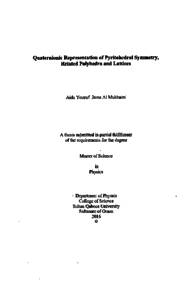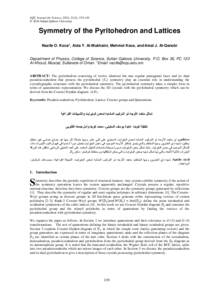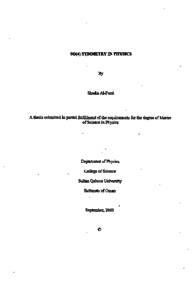Document
Quaternionic representation of pyritohedral symmetry, related polyhedra and lattices
Publisher
Sultan Qaboos University
Gregorian
2016
Language
English
English abstract
ABSTRACT
One of the most efficient tools in studying crystallography symmetry is to use quaternionic representation for the root system of the rank-3 Coxeter-Dynkin diagrams which correspond to the generating vectors of the lattices of interest. The cubic systems FCC (face centered cubic), BCC (body centered cubic) and SC (simple cubic) lattices can be constructed from the root and the weight lattices of the affine extended Coxeter groups W.(D) and W.(Bz) respectively.
The rank-3 Coxeter-Weyl groups W (D3) and W(B.) Aut(D2) describing the point. tetrahedral symmetry and the octahedral symmetry of the cubic lattices have extensive applications in material science. The constructions of the vertices of the Wigner-Seitz cells have been presented also in terms of quaternionic imaginary units. Reflection planes of the Coxeter-Dynkin diagrams are identified with certain planes of the unit cube,
The pyritohedral symmetry takes a simpler form in terms of quaternionic representation, We use Dz to construct the vertices of a family of polyhedra relevant to the cubic lattices in particular; constructions of the pseudoicosahedron and its dual pyritohedron are explicitly worked out. Many candidates of a parameter x give pseudoicosahedra and its dual pyritohedra as a structure in simple cubic lattice.
When x is the ratios of consecutive Fibonacci numbers approach to the golden ratio 1, we obtain a family of pseudoicosahedron approaching to icosahedron. The dual of this family of polyhedra gives a pyritohedron approaching to dodecahedron. The pseudoicosahedron and its dual pyritohedron play an essential role in understanding the crystallographic structures with the pyritohedral symmetry.
Description
Thesis
Member of
Resource URL
Arabic abstract
لقد وجدنا أن من أكثر الطرق فاعلية في دراسة تماثل البلورات هو استخدام وحدات العدد المركب التخيلي الرباعيات (Quaternions) لتمثيل نظام الجذر المخططات كوكستر. لنكن ( Coxeter - Dynkin ) ذات الرتبة الثالثة لتوليد متجهات الشبيكة الفراغية في نظام الشبيكات الفراغية المكعبة تم بناء شبيكات المكعب البسيط (SC) والمكعب متمرکز الجسم (BCC) والمكعب متمركز الوجه (FCC) کشبيكات جذريه وتثاقليه لمجموعات كوكستر (Coxeter الممتدة
إن مجموعات كوكستر - ويل ( Coxeter - Weyl ) ذات الرتبة الثالثة W(D3) وw(B3) = Aut ( D3) تصف التماثل الرباعي والثماني لشبيكة المكعب التي لها تطبيقات واسعة في علوم المواد . كذلك تم بناء أركان خلايا ويجنرزيتس ( Wigner – Seitz ) بدلالة وحدات العدد المركب التخيلي الرباعي وتم تحديد سطوح الإنعكاس لمخططات كوكسترلنكن يسطوح معينة في مكعب الوحدة
لقد اتضح أن تماثل متعدد الأوجه الإثنا عشري الغير منتظم (Pyritohedral Symmetry) يأخذ صورة بسيطة عند استخدام وحدات العدد المركب التخيلي الرباعي. كما تم استخدام مخطط D لبناء أركان عائله من متعددات الأوجه الثلاثية الأبعاد خصوصا متعدد الأوجه العشريني الغير منتظم (Pseudoicosahedron) ونظيره متعدد الأوجه الإثنا عشري الغير منتظم (Pyritohedron المرتبطة بشبيكات المكعب. العديد من الاختبارات للمتغير في المعادلة التي تعبر عن اركان متعدد الأوجه العشريني الغير منتظم أدت إلى الحصول عليه كبناء في شبكات المكعب البسيط
عندما تكون قيمة لا هي النسب المتعاقبة لأرقام متسلسلة فيبوناتشي (Fibonacci sequence) والتي تقترب من النسبة الذهبية (golden ratio) حصلنا على عائله من متعدد الأوجه العشريني الغير منتظم يقترب من شكل المتعدد الأوجه العشريني المنتظم (icosahedron ونظيره متعدد الأوجه الإثنا عشري الغير منتظم واللذي يقترب من متعدد الأوجه الإثني عشري المنتظم (dodecahedron). إن متعدد الأوجه العشريني الغير منتظم ونظيره متعدد الأوجه الإثنا عشري الغير منتظم يلعبان دورة أساسية في فهم هياكل البلورات التي تمتلك تمائل متعدد الأوجه الإثنا عشري الغير منتظم
إن مجموعات كوكستر - ويل ( Coxeter - Weyl ) ذات الرتبة الثالثة W(D3) وw(B3) = Aut ( D3) تصف التماثل الرباعي والثماني لشبيكة المكعب التي لها تطبيقات واسعة في علوم المواد . كذلك تم بناء أركان خلايا ويجنرزيتس ( Wigner – Seitz ) بدلالة وحدات العدد المركب التخيلي الرباعي وتم تحديد سطوح الإنعكاس لمخططات كوكسترلنكن يسطوح معينة في مكعب الوحدة
لقد اتضح أن تماثل متعدد الأوجه الإثنا عشري الغير منتظم (Pyritohedral Symmetry) يأخذ صورة بسيطة عند استخدام وحدات العدد المركب التخيلي الرباعي. كما تم استخدام مخطط D لبناء أركان عائله من متعددات الأوجه الثلاثية الأبعاد خصوصا متعدد الأوجه العشريني الغير منتظم (Pseudoicosahedron) ونظيره متعدد الأوجه الإثنا عشري الغير منتظم (Pyritohedron المرتبطة بشبيكات المكعب. العديد من الاختبارات للمتغير في المعادلة التي تعبر عن اركان متعدد الأوجه العشريني الغير منتظم أدت إلى الحصول عليه كبناء في شبكات المكعب البسيط
عندما تكون قيمة لا هي النسب المتعاقبة لأرقام متسلسلة فيبوناتشي (Fibonacci sequence) والتي تقترب من النسبة الذهبية (golden ratio) حصلنا على عائله من متعدد الأوجه العشريني الغير منتظم يقترب من شكل المتعدد الأوجه العشريني المنتظم (icosahedron ونظيره متعدد الأوجه الإثنا عشري الغير منتظم واللذي يقترب من متعدد الأوجه الإثني عشري المنتظم (dodecahedron). إن متعدد الأوجه العشريني الغير منتظم ونظيره متعدد الأوجه الإثنا عشري الغير منتظم يلعبان دورة أساسية في فهم هياكل البلورات التي تمتلك تمائل متعدد الأوجه الإثنا عشري الغير منتظم
Category
Theses and Dissertations



